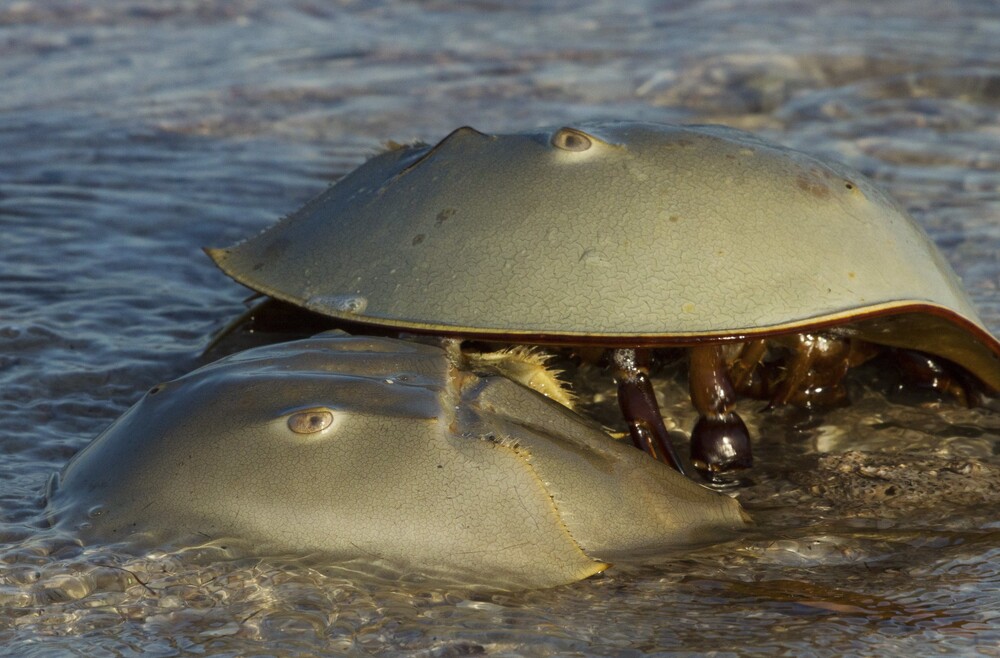
Horseshoe crabs — living fossils, unchanged for millions of years — are invaluable both to the migratory shorebirds that travel the length of the Western Hemisphere and to people in biomedical research. It’s their time again to emerge from the briny deep and do what comes naturally on the beach.
“I’ve actually seen a nesting pair kind of walking along, and they stopped,” said Kathy Mason, a Florida Horseshoe Crab Watch leader in Nassau County. “Right in front of us, the female started scooching down into the sand. It took about 20 seconds, and then you could hardly see her, and all you could see was the male on her back. That was really pretty cool.”
Floridians can expect horseshoe crabs to mate in multiples — three or four isn’t unusual in one grouping. But in habitats well-suited to the creatures like Jekyll Island in Georgia, people can find a dozen or more on the shore at the same time during nesting season.
“Scientists have determined that there’s an evolutionary benefit to unattached males to be hanging around (two others mating), because the process is external fertilization,” Mason said. “The female spawns her eggs out into the sand, and the male that’s on her back kind of has first dibs, if you will — he’s the closest.
“Research has found ‘satellite males’ also contribute their genetic material to the eggs … so there’s a benefit to hanging around, even if you’re not the guy that’s on her back.”
Nesting tends to occur in areas of low wave energy, which is why you don’t find as many horseshoe crabs on the Atlantic Ocean-facing sides of Amelia and Little Talbot islands. They are more plentiful slightly north on Cumberland and Jekyll islands where the waves come in much softer.
“We mostly see them at the north end and the south end (of Amelia Island), and that’s because the waves there are less energetic,” Mason said. “I’ve never seen live horseshoe crabs on the east side of the island — too much wave energy.”
While the eggs for birds and copper-based blood for biomedical research are two major contributions crabs make to the natural and human world, they’re also known as meals for other creatures.
“Our beloved loggerhead (sea) turtles here on Amelia do like to eat the full-grown adult (horseshoe crab),” said Joyce Tuten, a retired high school science teacher who assisted Mason in her presentation to the Fernandina Beach group Wild Amelia. “Not that many creatures can eat a full-grown adult, but loggerhead turtles can.”
Habitat destruction has put pressure on horseshoe crab populations, and fewer eggs means there’s less food for migratory shorebirds to conduct their hemispheric flights. It also puts into question the number and method of people harvesting the creatures.
Florida Horseshoe Crab Watch has statistics starting only in 2018 for Nassau County, so it’s a short time period. But the number of crab sightings decreased notably in 2019 —from 164 to 117. There were no sightings because of coronavirus protocols in 2020, and a concerningly small number, 39, seen last year.
“It’s pretty striking … look at the decline from 2018 to 2021,” Mason said. “What I would like to be very clear about is this is a very small data set, and it’s a very small number of years, so it’s important that we don’t kind of draw any important conclusions from this just yet, because it’s not enough data for us to say that. But it is a disturbing trend.”
The speculation among state biologists, Mason said, is that shoreline hardening could be playing a large part. She advised, though, that more data over a longer period of time is needed to get a better grasp of the situation.



